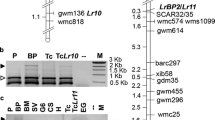Abstract
Leaf blight-resistant sorghum accession SC326-6 was crossed to the susceptible cultivar BTx623 to analyze the genetic basis for resistance. Field scoring of inoculated F2 progeny revealed that resistance was transmitted as a dominant single-gene trait. By combining the random amplified polymorphic DNA (RAPD) technique with bulked-segregant analysis, it was possible to identify PCR amplification products that␣segregated with disease response. Primer OPD12 amplified a 323-bp band (D12R) that segregated with resistance. Creation of longer primers, or SCARs (sequence characterized amplified regions) for D12R resulted in the amplification of a single major band of the predicted size from all the resistant F2 progeny and the resistant parent SC326-6, but not from BTx623 or 24 of 29 susceptible F2 progeny. The SCAR primers also amplified a single band with DNA from IS3620C, the female parent in a cross with BTx623 that has been used to produce a recombinant inbred population for RFLP mapping. An equivalent band was amplified from all 137 recombinant inbred progeny, indicating that organelle DNA is the amplification target in this cross.
Similar content being viewed by others
Author information
Authors and Affiliations
Additional information
Received: 31 July 1998 / Accepted: 23 November 1998
Rights and permissions
About this article
Cite this article
Boora, K., Frederiksen, R. & Magill, C. A molecular marker that segregates with sorghum leaf blight resistance in one cross is maternally inherited in another. Mol Gen Genet 261, 317–322 (1999). https://doi.org/10.1007/s004380050972
Issue Date:
DOI: https://doi.org/10.1007/s004380050972




